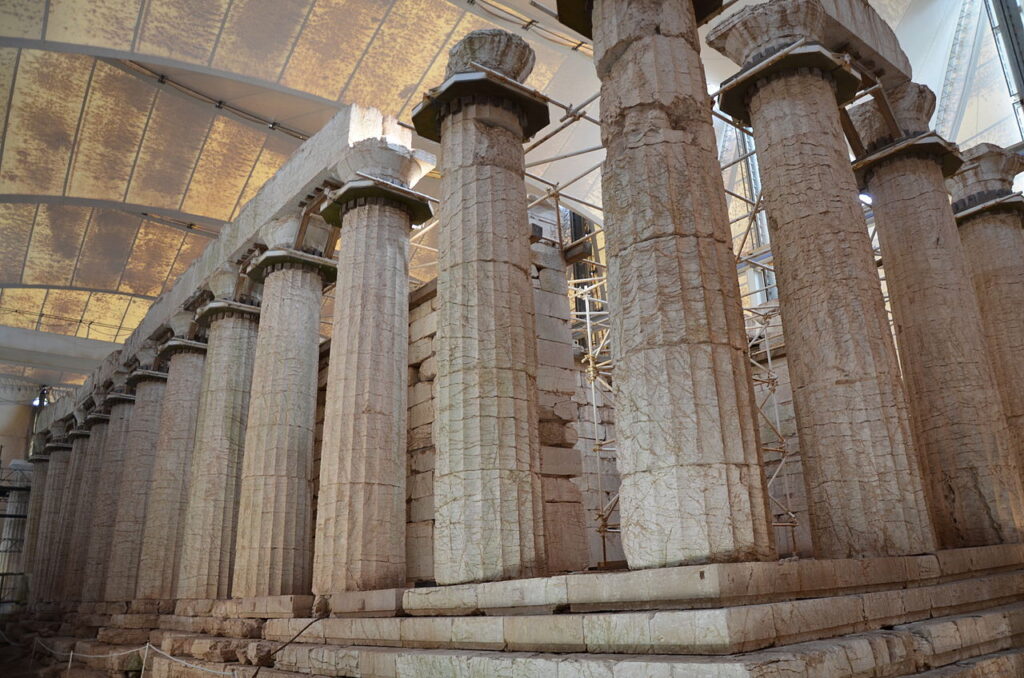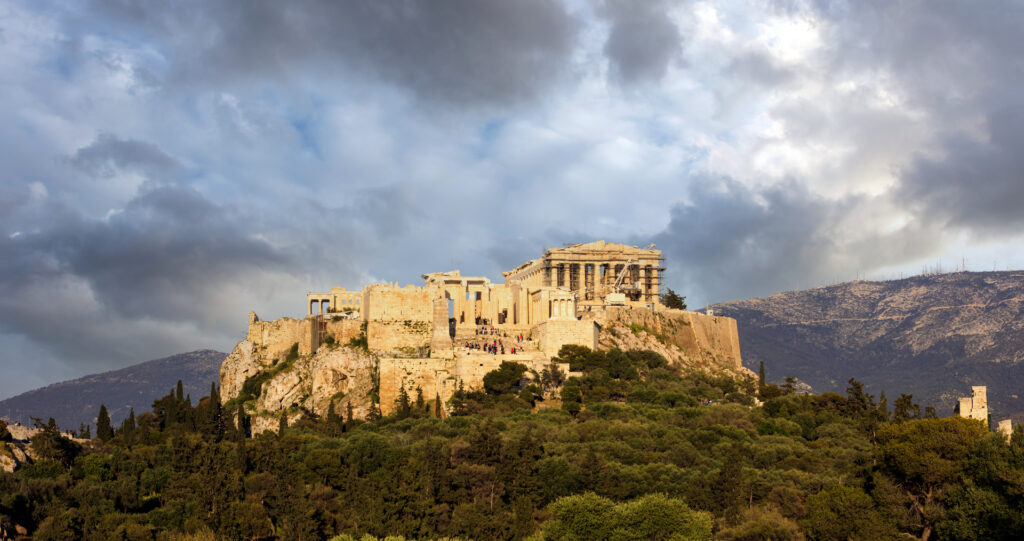La Grecia è un paese meraviglioso, ricco di storia, cultura, paesaggi mozzafiato e cibi deliziosi. Non c’è da sorprendersi, quindi, se questo paese è considerato una delle migliori mete di viaggio in Europa.
Se state pensando a un viaggio in questa terra e volete riscoprire le bellezze dell’antica Grecia, non potete perdervi questi 10 siti patrimonio dell’UNESCO:
1. Tempio di Apollo Epicuro a Bassae (1986)

L’antico tempio greco si trova nella regione dell’Arcadia (nel Peloponneso). L’edificio venne costruito da Ictino, l’architetto cui si deve la costruzione del Partenone e del Tempio di Efesto, nei pressi dell’Acropoli di Atene. Secondo Pausania l’edificio fu costruito fra il 450 e il 425 a.C. per esprimere riconoscenza nei confronti di Apollo, dio del sole e della salute, per aver risparmiato la città dalla pestilenza che infuriava in Grecia sul finire del V secolo a.C. Il tempio, che custodisce il più antico capitello corinzio mai trovato, combina lo stile arcaico e la serenità dello stile dorico con alcuni audaci elementi architettonici.
2. Acropoli di Atene (1987)

L’acropoli di Atene si può considerare la più rappresentativa delle acropoli greche. È una rocca, spianata nella parte superiore, che si eleva di 156 metri sul livello del mare sopra la città di Atene. Il pianoro ospita alcuni dei monumenti considerati simboli universali della civiltà classica e costituiscono il maggiore complesso architettonico e artistico che gli antichi greci abbiano lsaciato all’umanità. Completata nella seconda metà del V secolo a.C., quando Atene aveva assunto un ruolo guida tra le poleis greche, include opere dei più grandi artisti dell’antichità che, per volere di Pericle e sotto la guida di Fidia, realizzarono il Partenone, l’Eretteo, i Propilei e il Tempio di Atena Nike.
3. Sito archeologico di Epidauro (1988)

In una piccola valle del Peloponneso, il santuario di Asclepio, dio della medicina, si sviluppò da un precedente sito di culto di Apollo durante il VI secolo a.C., divenendo il luogo di culto ufficiale della polis di Epidauro. I suoi monumenti principali, in particolare il Tempio di Asclepio, il Tholos e il Teatro – considerato uno dei capolavori dell’architettura greca – risalgono al IV secolo a.C. Il vasto sito, coi suoi templi e l’edificio ospedaliero dedicato agli dei guaritori, offrono un prezioso sguardo sui culti di guarigione delle epoche greca e romana.
4. Città medievale di Rodi (1988)

L’ordine di San Giovanni di Gerusalemme occupò Rodi dal 1309 al 1523 e trasformò la città in una fortezza. Successivamente lo stato monastico cadde sotto il controllo dei Turchi e degli Italiani. Con il Palazzo dei Gran Maestri, l’Ospedale e la Via dei cavalieri, la Città Alta è uno dei migliori complessi urbani del periodo gotico. Nella Città Bassa l’architettura gotica coesiste con moschee, bagni pubblici e altri edifici del periodo ottomano.
5. Le Meteore (1988)

In una regione di falesie di arenaria quasi inaccessibili, monaci ortodossi si sono insediati su queste “colonne del cielo” a partire dall’XI secolo. Ventiquattro di questi monasteri erano stati costruiti, nonostante le incredibili difficoltà, al tempo del grande revival dell’ideale eremitico nel XV secolo. I loro affreschi del XVI secolo segnano una fase essenziale dello sviluppo della pittura post-bizantina.
6. Monte Athos (1988)

Centro spirituale ortodosso sin dal 1054, il Monte Athos ha goduto di uno status di autonomia fin dai tempi dell’Impero bizantino. La “Montagna Santa”, l’accesso alla quale è proibito a donne e bambini, è anche un riconosciuto sito artistico. La forma dei suoi monasteri (una ventina dei quali oggi abitati da circa 1400 monaci) ha un’influenza che si estende fino alla Russia e la sua scuola di pittura ha segnato profondamente la storia dell’arte ortodossa.
7. Monumenti paleocristiani e bizantini di Salonicco (1988)

Fondata nel 315 a.C., la capitale provinciale e città portuale di Tessalonica fu una delle prime basi di diffusione del Cristianesimo. Tra i suoi monumenti cristiani ci sono chiese che presentano sia la pianta a croce greca sia la struttura di basilica a tre navate. Costruite tra il IV e il XV secolo, costituiscono una serie tipologica diacronica che ha influenzato l’architettura dell’Impero bizantino. I mosaici della Rotonda, della Chiesa di San Demetrio e di San Davide sono tra i capolavori dell’arte paleocristiana.
8. Isola di Delo (1990)

Secondo la mitologia greca, Apollo nacque su questa piccola isola dell’arcipelago delle Cicladi. Il santuario di Apollo attraeva pellegrini da tutta la Grecia e Delo divenne un prospero porto commerciale. L’isola conserva tracce delle civiltà del mondo Egeo dal III millennio a.C. all’età paleocristiana. Il sito archeologico è straordinariamente esteso e ricco e offre l’immagine di un grande porto cosmopolita del Mediterraneo.
9. Sito archeologico di Micene e Tirinto (1999)

Questi due siti archeologici sono le imponenti rovine delle due principali città della civiltà micenea, che dominò il Mediterraneo orientale dal XV al XII secolo a.C. e giocò un ruolo fondamentale per lo sviluppo della cultura greca classica e dell’epica omerica che avrebbe influenzato la cultura europea per i successivi tre millenni.
10. Antica città di Corfù (2007)

La città vecchia di Corfù, sull’isola omonima, è situata in una posizione strategica all’ingresso del mare Adriatico e ha le sue radici nell’VIII secolo a.C. I tre forti della città, realizzati su progetto di eccellenti ingegneri veneziani, furono usati per quattro secoli per difendere gli interessi commerciali marittimi della Repubblica di Venezia contro l’Impero ottomano. Il patrimonio abitativo prevalentemente neoclassico della città vecchia è in parte di epoca veneziana e in parte successivo, in particolare del XIX secolo, durante il breve protettorato britannico.

182 Comments
By VictorMow
Remember when Lady Gaga ‘bled’ onstage during her shocking performance at the 2009 VMAs?
[url=https://www.youtube.com/watch?v=_t8HwqWe89o]русский анальный секс[/url]
Singing about the perils of fame, being dragged out from beneath a fallen chandelier then bleeding to death in front of a roomful of celebrities: Lady Gaga was not shy about making her debut at the MTV Video Music Awards.
The year was 2009 — many will remember it as the year rapper Ye (formerly Kanye West) stage-crashed 19-year-old Taylor Swift and suggested her award for Best Female Video should have gone to Beyonce instead. But never one to be overshadowed, Lady Gaga, then 23, made some pop culture history of her own that night.
Her rendition of “Paparazzi” — lamenting both unrequited love and the sinister effects of hounding tabloids — has gone down in the mists of Gaga legend; not least because a lack of high-quality footage means fans must resort to watching grainy screen-recorded versions circulated on social media.
Over the limited number of pixels, Gaga can be seen at the start of the performance in an all-white ensemble: a bejeweled, asymmetric lace bodysuit and matching cape, thigh-high boots, a feathered Keko Hainswheeler headpiece and strings of glinting pearls. As she staggered back from her piano at the song’s crescendo, however, an audible gasp swept the room as thick blood suddenly appeared to be pouring from her abdomen.
“I’m your biggest fan, I’ll follow you until you love me,” Gaga wailed desperately, her once-pristine outfit now daubed in scarlet. She ended the number suspended above the stage, ‘dead,’ as more blood dripped from her eyes.
“(It) gives me chills every time I watch it,” Olivia Rodrigo told MTV in 2021. “I think Lady Gaga is the best performer of our generation.” The “Drivers License” singer appeared to take notes. At this year’s Grammy Awards, she began to ‘bleed’ from clenched fists while performing her hit “vampire,” spreading fake blood across her arms and neck as the song progressed.
By MarlonFup
Medical staff on the front line of the battle against mpox in eastern Democratic Republic of Congo have told the BBC they are desperate for vaccines to arrive so they can stem the rate of new infections.
[url=https://blacksprut2rprrt3aoigwh7zftiprzqyqynzz2eiimmwmykw7wkpyad.com]bs2site2.at[/url]
At a treatment centre in South Kivu province that the BBC visited in the epicentre of the outbreak, they say more patients are arriving every day – especially babies – and there is a shortage of essential equipment.
блэкспрут даркнет
https://blackspfgh3bi6im374fgl54qliir6to37txpkkd6ucfiu7whfy2odid.shop
Mpox – formerly known as monkeypox – is a highly contagious disease and has killed at least 635 people in DR Congo this year.
Even though 200,000 vaccines, donated by the European Commission, were flown into the capital, Kinshasa, last week, they are yet to be transported across this vast country – and it could be several weeks before they reach South Kivu.
“We’ve learned from social media that the vaccine is already available,” Emmanuel Fikiri, a nurse working at the clinic that has been turned into a specialist centre to tackle the virus, told the BBC.
He said this was the first time he had treated patients with mpox and every day he feared catching it and passing it on to his own children – aged seven, five and one.
“You saw how I touched the patients because that’s my job as a nurse. So, we’re asking the government to help us by first giving us the vaccines.”
The reason it will take time to transport the vaccines is that they need to be stored at a precise temperature – below freezing – to maintain their potency, plus they need to be sent to rural areas of South Kivu, like Kamituga, Kavumu and Lwiro, where the outbreak is rife.
The lack of infrastructure and bad roads mean that helicopters could possibly be used to drop some of the vaccines, which will further drive up costs in a country that is already struggling financially.
At the community clinic, Dr Pacifique Karanzo appeared fatigued and downbeat having been rushed off his feet all morning.
Although he wore a face shield, I could see the sweat running down his face. He said he was saddened to see patients sharing beds.
“You will even see that the patients are sleeping on the floor,” he told me, clearly exasperated.
“The only support we have already had is a little medicine for the patients and water. As far as other challenges are concerned, there’s still no staff motivation.”
[url=https://bs2-clear.net]СЃРїСЂСѓС‚[/url]
By AlfredBar
Medical staff on the front line of the battle against mpox in eastern Democratic Republic of Congo have told the BBC they are desperate for vaccines to arrive so they can stem the rate of new infections.
[url=https://www-blackspfgh3bi6im374fgl54qliir6to37txpkkd6ucfiu7whfy2odid.com]СЃРїСЂСѓС‚[/url]
At a treatment centre in South Kivu province that the BBC visited in the epicentre of the outbreak, they say more patients are arriving every day – especially babies – and there is a shortage of essential equipment.
блэкспрут
https://bs2tsite4io.com
Mpox – formerly known as monkeypox – is a highly contagious disease and has killed at least 635 people in DR Congo this year.
Even though 200,000 vaccines, donated by the European Commission, were flown into the capital, Kinshasa, last week, they are yet to be transported across this vast country – and it could be several weeks before they reach South Kivu.
“We’ve learned from social media that the vaccine is already available,” Emmanuel Fikiri, a nurse working at the clinic that has been turned into a specialist centre to tackle the virus, told the BBC.
He said this was the first time he had treated patients with mpox and every day he feared catching it and passing it on to his own children – aged seven, five and one.
“You saw how I touched the patients because that’s my job as a nurse. So, we’re asking the government to help us by first giving us the vaccines.”
The reason it will take time to transport the vaccines is that they need to be stored at a precise temperature – below freezing – to maintain their potency, plus they need to be sent to rural areas of South Kivu, like Kamituga, Kavumu and Lwiro, where the outbreak is rife.
The lack of infrastructure and bad roads mean that helicopters could possibly be used to drop some of the vaccines, which will further drive up costs in a country that is already struggling financially.
At the community clinic, Dr Pacifique Karanzo appeared fatigued and downbeat having been rushed off his feet all morning.
Although he wore a face shield, I could see the sweat running down his face. He said he was saddened to see patients sharing beds.
“You will even see that the patients are sleeping on the floor,” he told me, clearly exasperated.
“The only support we have already had is a little medicine for the patients and water. As far as other challenges are concerned, there’s still no staff motivation.”
[url=https://btrhbfeojofxcpxuwnsp5h7h22htohw4btqegnxatocbkgdlfiawhyid.com]blacksprut площадка[/url]